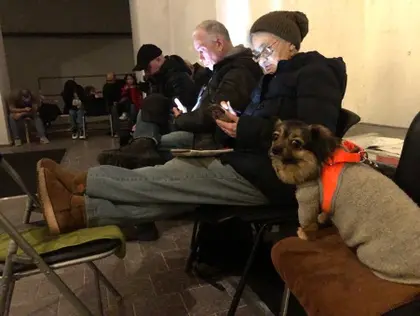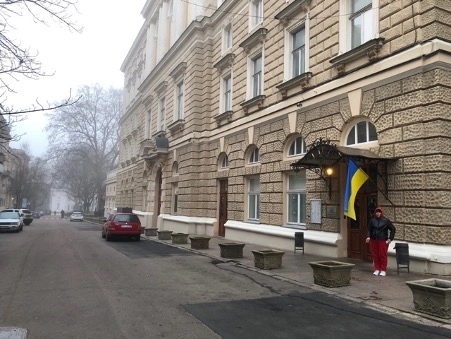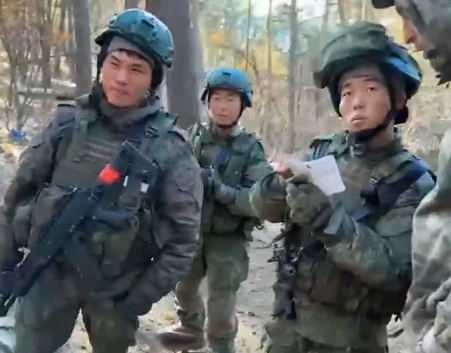The air-raid alert sounded at 11.30 p.m. on March 21, and after a few minutes we learned from the Telegram channels on our mobile phones that drones were on their way to Odesa.
During air-raid alerts, my wife and I usually leave the house and go to the stairwell landing. It’s the safest place in the building, because we are protected by the walls of the various apartments around us. From that shelter we listen to the deafening concert of anti-aircraft batteries firing at the drones.
JOIN US ON TELEGRAM
Follow our coverage of the war on the @Kyivpost_official.
You can often hear the sound of the drone’s motor approaching. A terrifying hum. We’ve set up some chairs in the corner, because this movie plays itself out almost every evening. There are always a couple of neighbors with us, a mother with her son. But not all our neighbors go to the stairwell. Many stay at home, despite the danger. Typically, after an hour or two the all-clear sounds and you go back to sleep.
But last night went differently. At 3:00 a.m. the alarm had not yet ceased when the Telegram channels informed us that there were several planes flying in firing positions. Those planes launch missiles that are difficult to shoot down. And the earlier drones helped consume the Ukrainian defenses’ ammunition.
By now we’ve all become experts in bombing tactics. The two most recent massacres in Odesa, 12 dead in a single destroyed building and another 21 from a double-tap missile strike, have made us understand that the danger has increased.

For the Record – Comments from Biden, NATO Secretary General
Artists’ entrance at the Odesa Opera Theater.
For the first time we leave the building and run toward the opera house, where the neighborhood’s bomb shelters are located. You enter from the rear entrance, that of the musicians and singers.
We’d already been in the basement of the theater before the Russian invasion, but with a guided tour. It’s become a tourist attraction because at the end of the 19th century, when the opera house was built, a fascinating labyrinth was built full of manholes open in the floor. They create a circulation system for fresh air to ventilate the theater, with a mechanical system during concerts in the summer.
Now those manholes are covered with metal sheets and canvas mats to prevent the night’s refugees from getting hurt. Now every time you step on it, the metal rumbles and makes a lot of noise.
In the first room, we find people sitting quietly on benches and chairs in the soft light, dazed by interrupted sleep. Entire families in pajamas and slippers. They got out of bed quickly and put on a jacket before running for cover. One of them is stretched out, able to sleep despite so many people chatting. There’s a lively group of smokers. They immediately recognize each other and leave the shelter every so often to smoke in the street. The alarms can’t compete with their need for nicotine. In this war I’ve heard of people who were saved because the restaurant they were eating in was hit while they were smoking outside.
There are also several dogs, I count six, but luckily, they don’t bark at each other. They’re probably too sleepy. In several corners there are water tanks, and on the wall a sign with the name of the wifi network. This is indispensable. In fact, everyone has their cell phone handy to read real-time air-raid updates.
Girl sheltering with dog, checking the phone.
At around 4:00 a.m. a new group of residents arrives. They decided to come after the news of missiles hitting Kharkiv and Zaporizhzhia. A mother appears with three daughters in the line-up and a grandmother in tow. I wonder where the father is. Then comes a little old lady in jeans and sport shoes, who starts talking loudly as if she were at the market. She turns to greet those who know her. She asks others to introduce themselves. She behaves like she’s the master of the house, sitting in the center of the room. To anyone who addresses her she gives a melancholy smile and a joke.
This is Odesa. People cling to irony even in the hardest moments. The enemy can’t depress this population.
By 5:00 a.m. the theater staff begins to appear. A cleaning lady wearing a burgundy blouse begins to do her routine among people with ease. On the street in front of the entrance, the small group of smokers continues to chat. A young soldier guarding the door joins them. At one point he bares his chest in the freezing cold of the night to show a tattoo to an admirer. Then the two introduce themselves and exchange phone numbers. The night of danger has created a friendship.
Dawn arrives and many decide to go home for a few hours of sleep, even though the all-clear alarm has not yet sounded. The general consensus is that the Russians have already launched all their planned missiles. We, too, embrace this belief and return home.
There’s a thick fog covering the view of the port and the sea. The silence of the city at that time is very evocative.
At 9:00 a.m. on March 22, the usual bulletin of what just flew over our heads arrives on our cell phones: 55 Shahed drones, 35 ballistic missiles (i.e., launched from ground ramps) and 2 aviation-launched missiles. Odesa was not hit this time. Unfortunately, there were more people killed or injured in other cities, and half of Ukraine is without electricity. But we are prepared for this too. Life must go on.
You can also highlight the text and press Ctrl + Enter












